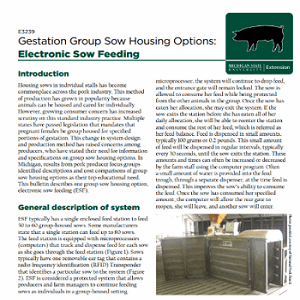By Beth Ferry
Due to the nature of pig production systems, pigs may have to be re-grouped at various stages, for example, entering the nursery stage, the feeder/finisher stage, at transport and/or immediately before slaughter. Vigorous fighting associated with re-grouping events can cause injury [3], stress [4], altered immune function [5], and reduced average daily gain [6]. This means re-grouping events can be associated with a reduction in productivity and pig well-being.

As Michigan focuses on converting their current gestation systems by April 1, 2020, from housing sows in individual gestation stalls to group housing sows once pregnancy is confirmed, more information is needed for producers. Pork producers have concerns regarding sow well-being and productivity in group systems due to injuries and lameness from aggression as well as the cost to implement these new systems.
At Michigan State University (MSU), a team of researchers are working on advancing the knowledge relating to the genetics and behavior of pig aggression, to further investigate the possibility, including potential side-effects of breeding a less aggressive pig. The overall aim of the project is to reduce production losses using behavioral and genomic tools to identify pigs best suited to group living more information on this topic can be found in the MSU Extension Pork Quarterly publication.
MSU Extension resources
Due to the current evolution of sow housing, the pork team at MSU Extension (MSUE) has identified it as an issue and area of education. The team conducted focus groups to identify strategic educational needs relating to the group housing of sows, which included: retrofitting existing facilities, feeding systems, employee training, new construction, genetics, and production scheduling [7]. In response to this, the team have put together factsheets outlining the systems available, which are published on the MSUE pork webpage, along with other industry information on gestation sow housing (GHS) options [8].
Also available on the website is the Sow Housing Options Tool (SHOT), which allows producers to economically evaluate group housing options, including new builds and retrofitting existing facilities. The SHOT consists of a standard Microsoft Excel spreadsheet along with a guide that allows users to input personalized farm data and cost estimates for various systems, in order to calculate a cost comparison for different systems, or directly compare the same system with equipment from different manufacturers. This enables users to complete an economic comparison of the GSH systems that they may consider adapting to, based on their individual production scheme. All materials are also available upon request as printed copies.
To complement existing materials, the team is currently developing video case studies of producers who have existing group sow housing systems. The videos will include a description of the system, and interviews with production staff responsible for sow management. Based on the outcome of the national pork producer, and industry advisor surveys, several educational materials will be constructed, relating to the breeding and selection of replacement breeding sows, and on-farm techniques to minimize aggression between pigs. MSU researchers will use the survey data to establish the best methods to communicate the latest research to pork producers, to better incorporate research advances into on-farm practice.
Source: msu.edu